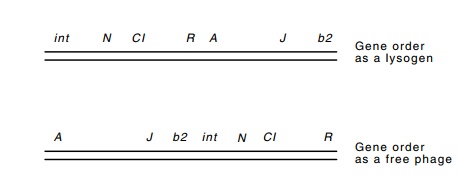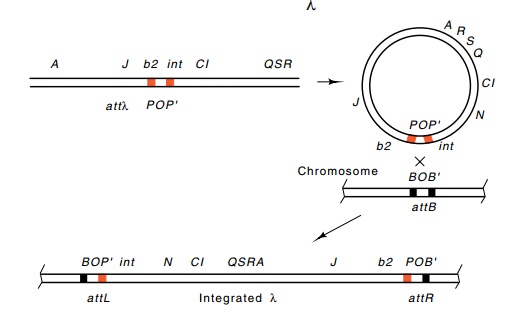Chapter: Genetics and Molecular Biology: Lambda Phage Integration and Excision
Gene Order Permutation and the Campbell Model
Gene Order Permutation and the Campbell Model
Determination of the lambda prophage gene order in
lysogens by deletion mapping exposed an anomaly. The order is a particular
circular

Figure
18.3 The gene orders of lambda phage
determined for lysogens bydeletion mapping and for lytically infected cells.
On the
basis of a small number of genetic experiments Campbell proposed a brilliant
explana-tion for the gene order problem and also made several other predictions
concerning problems on integration. The Campbell model was that the lambda DNA,
which is linear within the virion, circularizes upon enter-ing a cell and then
opens its genome at another point as it reciprocally recombines via a
site-specific recombination event mediated by a spe-cialized recombination
machinery into the chromosome of the host (Fig. 18.4). A simple notation has
developed for the DNA elements involved in integration and excision. The region
of the host DNA into which lambda inserts is labeled BOB’. B denotes the left
portion of the bacterial sequence into which lambda inserts, O is the crossover point or region of
the recombination between phage and chromosomal DNA, and B’ is the right portion of the bacterial sequence. The entire
region BOB’is called attB. Similarly, the phage regions are
called POP’ and attP.The products of integration are BOP’, which is also called attL,
and POB’, which is called attR. Note that this notation does not
prejudice the discussion by assuming that B
and P are homologous or that B is the same as B’. In fact, we can predict that the system would not depend on
lengthy homologies between BOB’ and POP’ because if it were, the general
recombination system could then recombine to insert or excise a phage genome.

Figure 18.4 The Campbell model for lambda integration. Linear phage DNAcircularizes soon after infection by association of the A and R ends. Integration occurs by means of a site-specific recombination event in the Oregions of the phage and bacterial DNA to generate the integrated phage. P and P’, and B and B’ are the phage and bacterial DNA sequences required for this process.
Related Topics